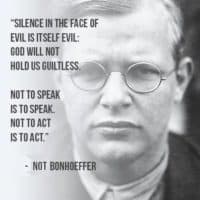
Dr. Stephen Nichols considers the life and work of Dietrich Bonhoeffer, a German theologian who was martyred as a direct order by Hitler himself.
Dietrich Bonhoeffer
Dietrich Bonhoeffer was born on February 6, 1906. He was martyred two months and three days into his thirty-ninth year. He was martyred on April 9, 1945, as a direct order by Hitler himself, while Bonhoeffer was in a concentration camp. In between, Dietrich Bonhoeffer was a Lutheran theologian, a pastor, and an author. He was born into an academic family; his father was an MD and PhD, and he taught medicine and psychology at the University of Berlin. This was a family who also loved music. The Bonhoeffers had a large family parlor, and there are often stories Dietrich would tell later of the family writing oratorios in honor of their parent’s birthdays or anniversaries, and the whole family would gather together to perform.
Early on, Bonhoeffer was destined for a life of academics and a career in academics. As a young man he went off to university, and, as he was twenty going on twenty-one, he received what would be his first doctorate. Following that, he went to Barcelona and served for a year or so as a youth pastor. This was mostly to Germans who were there in Barcelona for government work or through industry, and he did some preaching and youth ministry there. He went back to Berlin, received a second doctorate, wrote a philosophical treatise called Act and Being, and received an appointment as a professor at Berlin. He convinced his supervisors that it would be good for him to come to America and study theological developments in America.
In 1930, Bonhoeffer came to New York City and he ended up at Union Theological Seminary. When he saw the theological developments there, he did not like them. He saw liberalism, he saw that there was nothing to preach; he visited these big pulpits, he visited Harry Emerson Fosdick’s church in New York City, and he said, “Abysmal,” —it is what he wrote in his diary. And then he wrote, “There is no theology here.” He ended up going on a road trip from New York City all the way to Mexico in the winter of 1930, and he also spent significant time in some African-American churches in the city. He went to a large church in the morning, but in the afternoon, he went to a storefront church in Harlem. It was also there that he was introduced to the Negro Spirituals, so when he went back to Germany he had armfuls of vinyl records that he would take back, and when he was a professor at the University of Berlin, he would often play those records for his students.
 He ended up lecturing in Berlin. He lectured on Christology and the opening chapters of Genesis, and then the Nazis came into power. Eventually, Bonhoeffer lost his license to teach at the university, he was kicked out of the university, and he was banned from writing and his books were banned. But, he became a director of the underground seminary. That seminary originally met at Finkenwalde, and it was closed by the Gestapo in 1937, and the next year Bonhoeffer wrote his famous little book, Life Together, recalling the times together at Finkenwalde. He became involved in the resistance movement once the war was in full step, and he was even involved with groups that were planning to assassinate Hitler. It does not seem like Bonhoeffer played any military or strategic role, but this group that he was involved in had military officials. He was the theologian in the room that these folks looked to give them some ethical guidance. They were trying to figure out what to do in response to what was happening to their country and what they saw Hitler doing. It was for that involvement that Bonhoeffer was eventually arrested and taken to prison in Tegal. Then, following the Valkyrie plot, all of these former folks that were involved in these assassination attempts were gathered up and brought into Berlin. As the war was about to come to a close, Dietrich Bonhoeffer was moved from Berlin to Buchenwald, and then to Regensburg. Then, he had his final move to the concentration camp at Flossenburg, and there he was hanged on April 9, 1945.
He ended up lecturing in Berlin. He lectured on Christology and the opening chapters of Genesis, and then the Nazis came into power. Eventually, Bonhoeffer lost his license to teach at the university, he was kicked out of the university, and he was banned from writing and his books were banned. But, he became a director of the underground seminary. That seminary originally met at Finkenwalde, and it was closed by the Gestapo in 1937, and the next year Bonhoeffer wrote his famous little book, Life Together, recalling the times together at Finkenwalde. He became involved in the resistance movement once the war was in full step, and he was even involved with groups that were planning to assassinate Hitler. It does not seem like Bonhoeffer played any military or strategic role, but this group that he was involved in had military officials. He was the theologian in the room that these folks looked to give them some ethical guidance. They were trying to figure out what to do in response to what was happening to their country and what they saw Hitler doing. It was for that involvement that Bonhoeffer was eventually arrested and taken to prison in Tegal. Then, following the Valkyrie plot, all of these former folks that were involved in these assassination attempts were gathered up and brought into Berlin. As the war was about to come to a close, Dietrich Bonhoeffer was moved from Berlin to Buchenwald, and then to Regensburg. Then, he had his final move to the concentration camp at Flossenburg, and there he was hanged on April 9, 1945.
Stay connected with 5 Minutes in Church History by getting the weekly podcast on iTunes, SoundCloud, or via RSS. You can also subscribe to the blog via RSS and follow us on Twitter and Facebook.
(This podcast is by Ligonier Ministries. Discovered by Christian Podcast Central and our community — copyright is owned by the publisher, not Christian Podcast Central, and audio is streamed directly from their servers.)